At my book club meeting, I learned something pretty fascinating. We were getting together to start the year, so we weren't discussing any book in particular, just having dinner and conversation. One of our number is a fourth grade teacher and she told us about all the things she and her class learned when a comic book aficionado came to speak to her class.
The same guy who invented Wonder Woman also invented the lie detector, the comic book aficionado said. Makes sense, right? The Golden Lasso compels people to tell the truth.

Wonder Woman, all tied up, 1940s style
(Image from Sideshow Collectibles)
Contrary to what you might think from that panel from his comic strip, this Wonder Woman-guy truly believed in the power of women. All that stuff about Wonder Woman being an Amazon--he really believed all that. He thought that someday, women would be the more powerful sex because in many ways they already were, so it was just a matter of time.
And, the comic book aficionado told the teachers after the kids had been dismissed, the creator of Wonder Woman and the lie detector was also in a polyamorous relationship. That is, he was married to a woman, but actually lived with two women, had children with both. The three of them lived together as a happy (though secret) family.

William Moulton Marston and his four children -- by two women.
(Photo from Comic Book Resources)
Of course I had to learn more.
More, as it turns out, includes a whole theory of dominance and submission--in a utopian sense, of course. So how are all these things connected in the same person?
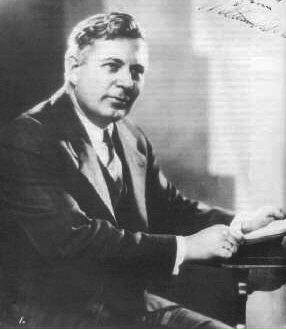
William Marston, one of the inventors of the lie detector
(Photo from The Polygraph Museum)
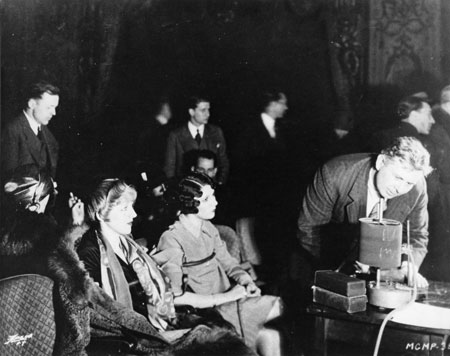
Marston showing movies to brunettes and blondes attached to his lie detector
(Photo from The Lie Detectors)
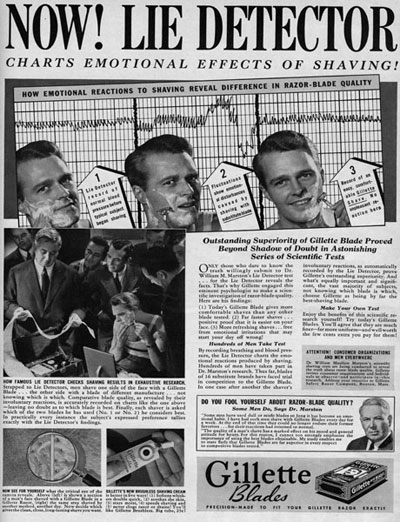
A firm believer in the popular press, Marston also used a Gillette razor ad to promote his lie detector.
(Photo from The Lie Detectors)
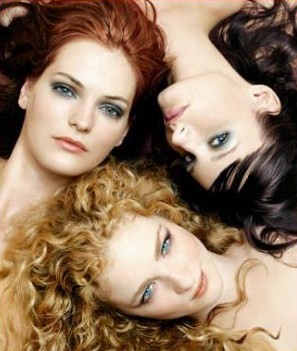
Marston would have been determined to find out which of these women would be more dominant--based on the color of their hair.
(Photo from Wilson Art Hair Gallery)

Pretty much how Marston saw the future--women saving and ruling the world.
(Photo from Toner Doll Duels)

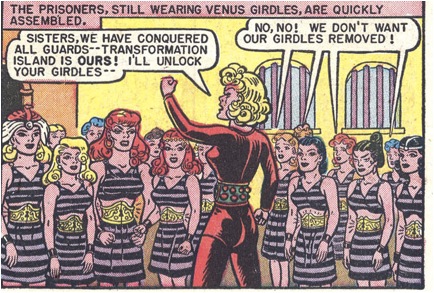
Prisoners on Reform Island (later named Transformation Island) wearing their Venus girdles
(Image from the Hooded Utilitarian)
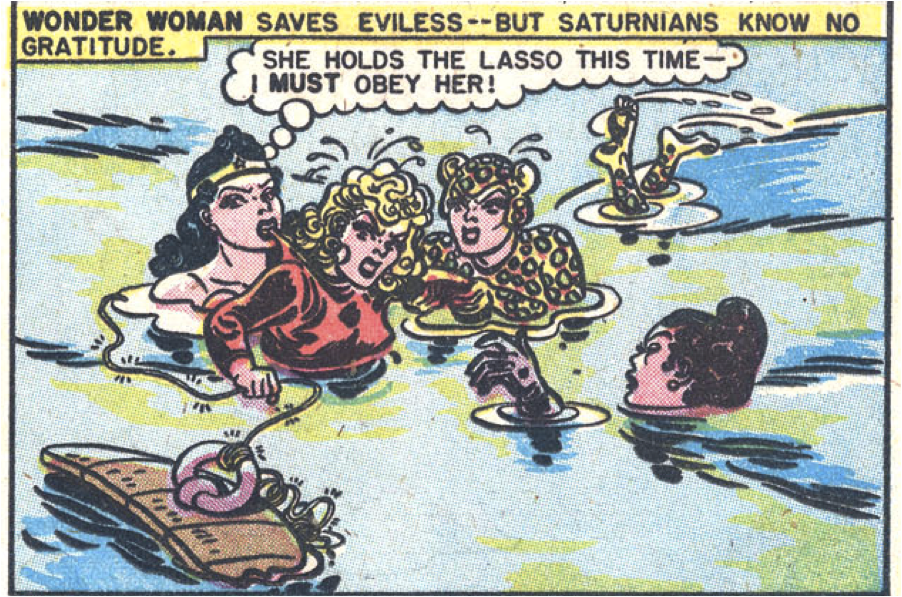
Wonder Woman using her Golden Lasso (though you can't really see it) to make a criminal obey.
(Image from the Hooded Utilitarian)
 Lynda Carter sporting the Bracelets of Submission which, by the time the TV show came around, were nothing like the original though they did have the power to repel bullets. I wanted bracelets like that.
Lynda Carter sporting the Bracelets of Submission which, by the time the TV show came around, were nothing like the original though they did have the power to repel bullets. I wanted bracelets like that.
(Photo from Screened)

Wonder Woman bound and unbound, on page 10 from the first Wonder Woman #21, Jan-Feb 1947
(Image from Comic Book Resources)

I'm sure it was a very deliberate choice on Marston's part to make her brunette, so it's curious that Wonder Woman looks blonde here.
(Image from Flavin's Corner)
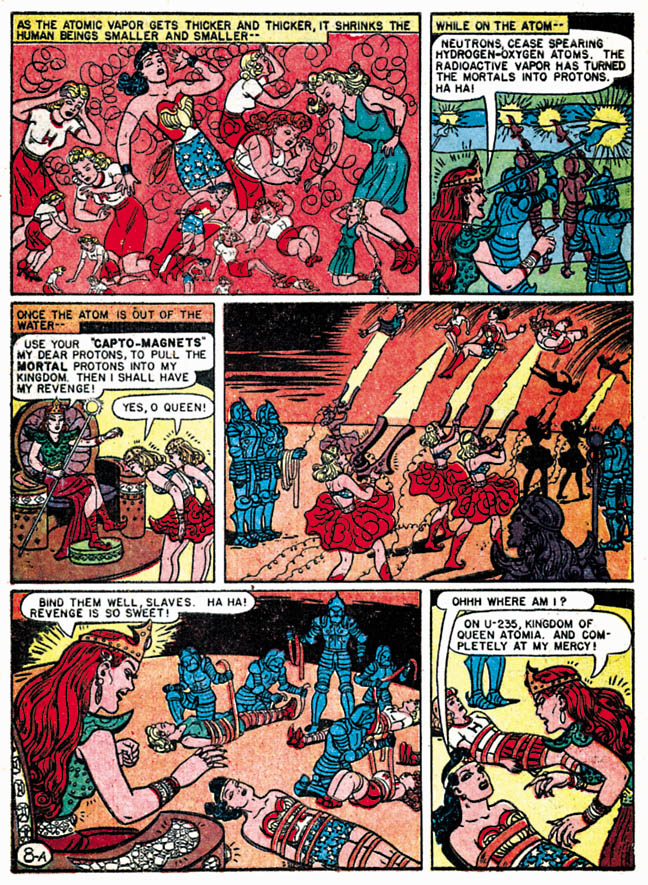
In case you can't read it, the key dialogue here is "Bind them well, slaves. Ha ha! Revenge is so sweet." From the first Wonder Woman #21, Jan-Feb 1947

Here's Marston conducting one of his lie detector tests on a woman wearing a blindfold? mask? That's Olive standing behind the screen, taking notes.
(Photo from Flavin's Corner)

Marston is seated in the center, that's Olive in the white blouse behind his shoulder, Elizabeth is in the right corner looking sideways at the camera, and the girl on Marston's knee is the daughter named after Olive. The woman with the square jaw in the left corner is someone named Marjorie Wilkes. Maybe she was a third woman in the Marston family? She was an assistant who worked on the comic.
(Photo originally from Wonder Woman: The Complete History, sourced from Flavin's Corner)
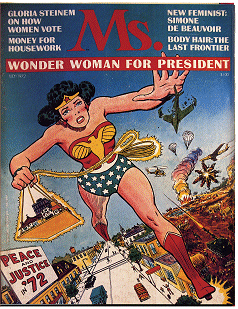
Inaugural issue of Ms. magazine, featuring Wonder Woman
(Photo from a Tumblr page of Ms. magazine)

Wonder Woman, as drawn by Nicola Scott
(Image from Comic Vine)
Sources
International League of Polygraph Examiners, Polygraph/Lie Detector FAQs
Geoffrey C. Bunn, The lie detector, Wonder Woman, and liberty: the life and work of William Moulton Marston, History of the Human Sciences, 1997
American Psychological Association, Wonder Woman: A psychologist's creation, December 2008
Board on Behavioral, Cognitive, and Sensory Sciences and Committee on National Statistics, The Polygraph and Lie Detection, The National Academies Press, pp 292 ff.
Margarita Tartakovsky, A Psychologist and a Superhero, PsychCentral, May 17, 2011
Suffering Sappho! A Look at the Creator & Creation of Wonder Woman, Comic Book Resources, August 23, 2006
The Periodic Table of Comic Books, Wonder Woman
Philip Charles Crawford, The Legacy of Wonder Woman, School Library Journal, March 1, 2007
The same guy who invented Wonder Woman also invented the lie detector, the comic book aficionado said. Makes sense, right? The Golden Lasso compels people to tell the truth.

Wonder Woman, all tied up, 1940s style
(Image from Sideshow Collectibles)
Contrary to what you might think from that panel from his comic strip, this Wonder Woman-guy truly believed in the power of women. All that stuff about Wonder Woman being an Amazon--he really believed all that. He thought that someday, women would be the more powerful sex because in many ways they already were, so it was just a matter of time.
And, the comic book aficionado told the teachers after the kids had been dismissed, the creator of Wonder Woman and the lie detector was also in a polyamorous relationship. That is, he was married to a woman, but actually lived with two women, had children with both. The three of them lived together as a happy (though secret) family.

William Moulton Marston and his four children -- by two women.
(Photo from Comic Book Resources)
Of course I had to learn more.
More, as it turns out, includes a whole theory of dominance and submission--in a utopian sense, of course. So how are all these things connected in the same person?
William Moulton Marston, Ph.D., Academic & Inventor
- William Moulton Marston, creator of Wonder Woman and the lie detector, was a Harvard graduate with no less than three degrees: Bachelor's (1915), law (1918), and psychology (1921).

William Marston, one of the inventors of the lie detector
(Photo from The Polygraph Museum)
- He began his academic career very interested in the science of deception. As an undergraduate, he came up with the concept of the lie detector.
- Actually, it was his wife, Elizabeth, who gave him the idea. She told her husband that “When she got mad or excited, her blood pressure seemed to climb.” This eventually led Marston to develop an apparatus that tracked and recorded changes in blood pressure, with the implication that such changes would indicate when someone was lying.
- He tried to get his lie detector used in court, but some people were skeptical that blood pressure alone would be enough to detect deception, so it wasn't really adopted by the law enforcement community.
- In fact, the guy who is now widely credited with inventing the lie detector, John Augustus Larson, used some of Marson's ideas, but his machine tracked blood pressure, pulse, and respiration.
The Lie Detector as a Bondag-- er, Research Tool
- That didn't stop Marston from claiming that he invented the lie detector. He published all sorts of articles -- mainly in popular magazines and newspapers -- saying he had invented the lie detector.
- People bought what he was selling. His entry in the Encyclopedia of American Biography says he was the lie detector's inventor. People all over the internet still say he was its inventor.
- But he had moved on from the law to psychology. He started using his lie detector in the service of his psychology "experiments."
- I put "experiments" in quotation marks because more academically-minded psychologists might beg to differ with the quality of his research--especially by today's standards. But Marston believed they were scientific, controlled studies. He preferred to interpret his results in lay terms and publish them in popular magazines such as Look and Family Circle because he believed that psychology could set people free, and he wanted to reach as many people as possible.
- One way he used his lie detector was to put it on a series of female volunteers and ask them questions about their love lives. If their blood pressure went up when asked about their neglectful husbands, he concluded that they were still in love with their spouses. Another pair, he declared, were really in love with each other though they were engaged to other people.
- He did other studies where he went to sorority houses while they had "baby parties" in which the women tied each other up and disciplined or spanked each other. He had them put on his lie detector and gauged their reactions to disciplining each other or being disciplined. No, I am not making this up!
- Another part of his research focused very extensively on trying to correlate women's hair color with their emotions, and he used his lie detector in service of that research. In another study, he showed movie scenes to female volunteers who wore his lie detector. The scenes he showed were of a boxer winning a fight (dominating), and of a girl who was dancing because she was a captive of some Tibetan priests (submission). He also showed them a love scene between Greta Garbo and John Gilbert.
- Marston declared that his study proved that "brunettes enjoy the thrill of pursuit," while blondes "prefer the more passive enjoyment of being kissed."

Marston showing movies to brunettes and blondes attached to his lie detector
(Photo from The Lie Detectors)
- This particular study was done in front of a press corps. In spite of teasing him with questions like, "How do we know she's a real blonde?" the reporters ate it up. The New York Times published an article with the headline: "Blondes Lose Out in Film Love Test. Brunettes Far More Emotional. Psychologist Proves by Charts and Graphs."
- This was in 1928, and Marston's research hit several popular hot-spots. Freudian psychology was taking off, as was research into sexuality, and so were the movies.
- In fact, Universal Studios took Marston's research so seriously, they invited him to come work for them as a "consulting psychologist" to help them determine what movies would succeed with which audience members.

A firm believer in the popular press, Marston also used a Gillette razor ad to promote his lie detector.
(Photo from The Lie Detectors)
Marston's Color Theories
- It's not clear whether he actually helped the movie studio decide which movies were going to do better at the box office, but Marston did get to do all kinds of research into blondes, brunettes, and red-heads.
- He was also hired as a consulting psychologist for Family Circle, and he published a lot of his hair-color research there, and in other women's magazines such as Cosmopolitan, Good Housekeeping, and the Ladies' Home Journal.
- Katharine Hepburn, he said, "demonstrated some typical red-haired traits (aggressiveness and energy)" while "Blond Betty Grable's pride in showing her figure is a trait typical of fair-haired girls."
- (Women's magazines still publish stuff like this, don't they? Or am I only remembering articles I used to see when I was in high school?)
- The reason he was so interested in hair color (and eye color, too) was because he was trying to connect "primary colors" with "primary emotions." He wanted to know if you could predict how someone would react emotionally based on their hair and eye color.
- Actually, he wanted his research to show what he already believed, which was that specific colors were associated with specific emotions.
- His beliefs about the relationship between colors and emotions led him to make statements like this:
"Yellow . . . has always been the imperial colour of the Chinese. . . . [I]t is commonly recognized by those most conversant with Chinese philosophies, social customs, art, and religion, that the Chinese civilization has been built, primarily, upon an emotional response of submission."
- Hogwash, right? Just keep that in mind as we proceed.
Marston's Theory of Dominance and Submission
- Marston believed that the four primary, or most elemental, emotions were not love or anger or fear, but rather dominance, compliance, submission, and inducement.
- He didn't like the theories of neurology and the neuron-synapse relationship that were emerging at the time. He thought the neurologists and the behaviorists were sweeping aside emotion completely and they were missing the boat.
- The basis for human behavior, he said, was not the neuron by the psychon. I'm not really clear on how he defined psychon, only that he meant that emotions formed the basic element of human behavior. Emotions came about as the result of conflict between at least two impulses.
- Every emotion, he believed, emerged after a struggle within us for -- you guessed it -- dominance.
- So he saw everything in terms of a struggle of one thing versus another. The struggles that interested him the most were between the sexes and within the self.
- He connected his four primary emotions with four primary colors. Dominance was blue and submission was yellow. Compliance, which he said was kind of a passive interest in what's around you, was green, while inducement, which was getting other people to submit further, was red.
- This was why, he said, men generally prefer blue because men are generally more dominant. But a man who is cowardly would say yellow is his favorite color.
- Yep. Really scientific.
- That's also why he was so interested in the hair and eye color of women--he wanted to know if dark-haired or light-haired women were either dominant or submissive, and whether the color of their eyes figured into that equation, too.
Marston would have been determined to find out which of these women would be more dominant--based on the color of their hair.
(Photo from Wilson Art Hair Gallery)
Submission is a Good Thing
- It might sound like Marston was ho-hoing in triumph when he said that men were generally more dominant, but that's not the case at all. He said it was basically a mistake when women acted submissive because they were really only pretending and doing themselves a disservice, getting themselves all twisted up with repression and emotional conflicts.
- He said that his experiments proved that "women prefer captivating men, and that men prefer to be captivated." He said that men don't want a woman to be submissive, but that a man prefers to "walk captive behind her chariot."
- He also said that what looks like submission in women is really something else. "Women's erotic emotions which appear submission actually consist, for the most part of active inducement emotion." In other words, they're not really submitting to anything but rather secretly trying to get men to submit to them.
- During World War II especially, he saw women gaining more power. In a 1942 interview, he said, "I tell you, my inquiring friend, there's great hope for this world. Women will win! Give them a little more time and the added strength they'll develop out of this war and they'll begin to control things in a serious way."

Pretty much how Marston saw the future--women saving and ruling the world.
(Photo from Toner Doll Duels)
- He saw women in power as a good thing because men's primary definition of success was in terms of material gain, which was a very limited perspective. Women, however, defined success in terms of happiness, and not just their own but the happiness of the people around them. So a society in which women were dominant would be a society in which people were happier.
- Learning submission would be a good thing, not just for men, but for everybody. To be truly free--and not just in terms of the relationship between the sexes, but in all things--one must learn "that all-important social trait, willing submission to other people."
- Criminals, he said, were simply people who had not learned to submit to the state, which should operate like a loving authority. "The lawbreaker is a social rebel who cannot enjoy the experience of yielding his own will to someone else's, while the law-abiding citizen is a socially-minded individual who enjoys submitting to others on a majority of occasions."
- Enter the Golden Lasso.

Wonder Woman, the Golden Lasso of Truth, and the Bracelets of Submission
- He wanted to help women realize they didn't need to be submissive, that they could be dominant and possessed that capability innately. So he chose an even more popular-culture way than women's magazines to reach them: a comic strip.
- When Marston (under the pen name Charles Moulton) created Wonder Woman in 1941, her entire world corresponded with his theories of dominance and submission.
- Wonder Woman was an Amazon who lived on Paradise Island, a place where women ruled supreme in harmony. She wielded the Golden Lasso which, when wrapped around a criminal, rendered him immobile and submissive, compelled to tell the truth -- like a lie detector, but with more bondage.
- She worked undercover for the US military intelligence, but her greatest enemy was the Duke of Deception.
- Just off the shore of Paradise Island was Reform Island where prisoners were transformed by loving discipline. Each prisoner had to wear the Venus girdle which would make him want to become submissive to loving authority.
- Wonder Woman was never completely secure in her dominant position, however. Aphrodite made the Amazons wear the Bracelets of Submission which served as reminders of what could happen if women submitted to the domination of men.
- If a man chained the bracelets together, the woman would lose her special Amazonian strength and the man cold control her. If the bracelets were taken off, the woman would become "uncontrolled! . . . free to destroy like a man!"
- So the place was built to operate between the competing struggles of male and female, dominance and submission.

Prisoners on Reform Island (later named Transformation Island) wearing their Venus girdles
(Image from the Hooded Utilitarian)

Wonder Woman using her Golden Lasso (though you can't really see it) to make a criminal obey.
(Image from the Hooded Utilitarian)

(Photo from Screened)
Tie Me Up, Tie Me Down
- You would think that Wonder Woman would therefore run around tying everybody up. But actually it was Wonder Woman who kept getting tied up -- and chained, and blindfolded, and handcuffed, and all sorts of otherwise restrained.

Wonder Woman bound and unbound, on page 10 from the first Wonder Woman #21, Jan-Feb 1947
(Image from Comic Book Resources)
- Marston didn't think it was that big a deal because the whole point was to show how she could escape such domination, so the reader always got a happy ending (ahem). But not everybody was familiar with Marston's theories about the socially-beneficial properties of bondage.
- One reader, a soldier in the infantry, wrote to him saying,
"I am one of those odd, perhaps unfortunate men who derive an extreme erotic pleasure from the mere thought of a beautiful girl, chained or bound, or masked, or wearing extreme high-heels or high-laced boots--in fact, any sort of constriction or strain whatsoever. Your tales of Wonder Woman have fascinated me on [this] account. . . . Have you the same interest in bonds and fetters that I have?"
- (A lot of people cite this letter as evidence of Marston's interests, but it was not written by Marston.)

I'm sure it was a very deliberate choice on Marston's part to make her brunette, so it's curious that Wonder Woman looks blonde here.
(Image from Flavin's Corner)
- The infantryman wasn't the only one who noticed all the bondage going on in Wonder Woman. A member of the editorial board of DC Comics complained about the strip's "sadistic bits showing women chained, tortured, etc."
- Someone on the Child Study Association said "there was a considerable amount of chains and bonds. So much so that the bondage idea seemed to dominate the story." I wonder if he was aware of the pun there.
- Marston was frustrated by this response. He didn't see the comic as being sadistic at all. He wrote to one of his detractors, saying, "Wonder Woman binds the victims in love chains--that is, she makes them submit to a loving superior, a beneficent mistress or master who in every case represents 'God,' or Goodness, or Aphrodite, Goddess of Love and Beauty."
- He did also say in that 1942 Family Circle interview:
"Tell me anybody's preference in story strips and I'll tell you his subconscious desires... Superman and the army of male comics characters who resemble him satisfy the simple desire to be stronger and more powerful than anybody else. Wonder Woman satisfies the subconscious, elaborately disguised desire of males to be mastered by a woman who loves them."
- Even so, Marston capitulated (should we be surprised?) and agreed with his publisher to reduce "the use of chains by at least 50 to 75%."

In case you can't read it, the key dialogue here is "Bind them well, slaves. Ha ha! Revenge is so sweet." From the first Wonder Woman #21, Jan-Feb 1947
(Image from the Periodic Table of Comic Books)
Meanwhile, Back at the Ranch
- That 1942 interview in Family Circle? That was conducted by Olive Richard or Olive "Bobby" Byrne. Marston said she was his inspiration for Wonder Woman and that her heavy, silver bracelets were the source of the idea for the Bracelets of Submission. She was a former student and research assistant of his.
Here's Marston conducting one of his lie detector tests on a woman wearing a blindfold? mask? That's Olive standing behind the screen, taking notes.
(Photo from Flavin's Corner)
- Olive moved in with Marston and his wife, Elizabeth -- the one who noticed her blood pressure went up when she got angry or excited -- in the 1920s.
- It seems that Olive and Elizabeth got along fine. Olive bore two of Marston's sons, and Elizabeth also had two children by Marston. The two of them reared his children together, and Elizabeth even adopted Olive's sons. She named one of her daughters after Olive.
- Elizabeth was no doormat. She had degrees in law and psychology, just like her husband, and she worked to put herself through school and continued to work while her children were growing up. Marston's children have said "It was a wonderful situation, a win-win deal for everyone."
- Marston contracted polio and then skin cancer and died in 1947, after having written the Wonder Woman comic strip for six years.
- After he died, Elizabeth and Olive simply continued living together. Elizabeth died in 1993, age 100.
Marston is seated in the center, that's Olive in the white blouse behind his shoulder, Elizabeth is in the right corner looking sideways at the camera, and the girl on Marston's knee is the daughter named after Olive. The woman with the square jaw in the left corner is someone named Marjorie Wilkes. Maybe she was a third woman in the Marston family? She was an assistant who worked on the comic.
(Photo originally from Wonder Woman: The Complete History, sourced from Flavin's Corner)
Wonder Woman, post Marston
- After his death, some psychologist wrote a treatise in which he claimed that Wonder Woman and her fellow Amazons were all a bunch of lesbians and they presented a "morbid ideal" for girls and threatened boys' masculinity. So the people who were still writing the comic changed a lot of things.
- A lot of the bondage disappeared, the comic developed a much stronger interest in marriage and romance, and a lot of the feminism disappeared too.
- By the late 1960s when she'd been watered down to the human Diana Prince with almost zero superpowers, and her popularity having plummeted, DC Comics enlisted the help of none other than Gloria Steinem in revamping her character.
- When people say that Gloria Steinem put Wonder Woman on the cover of her first issue of Ms. magazine in 1972, they mean to suggest that this is evidence of Wonder Woman's staying power, not Steinem's self-promotion. But I think Marston would have been very pleased that it was, in fact, both.

Inaugural issue of Ms. magazine, featuring Wonder Woman
(Photo from a Tumblr page of Ms. magazine)
- Today, Wonder Woman remains the third-longest running comic book in history behind the giants of Superman and Batman. About 90% of the comic's readership is male.

Wonder Woman, as drawn by Nicola Scott
(Image from Comic Vine)
Sources
International League of Polygraph Examiners, Polygraph/Lie Detector FAQs
Geoffrey C. Bunn, The lie detector, Wonder Woman, and liberty: the life and work of William Moulton Marston, History of the Human Sciences, 1997
American Psychological Association, Wonder Woman: A psychologist's creation, December 2008
Board on Behavioral, Cognitive, and Sensory Sciences and Committee on National Statistics, The Polygraph and Lie Detection, The National Academies Press, pp 292 ff.
Margarita Tartakovsky, A Psychologist and a Superhero, PsychCentral, May 17, 2011
Suffering Sappho! A Look at the Creator & Creation of Wonder Woman, Comic Book Resources, August 23, 2006
The Periodic Table of Comic Books, Wonder Woman
Philip Charles Crawford, The Legacy of Wonder Woman, School Library Journal, March 1, 2007
This is a really fascinating post. Amazing things brought to us by the Apple Lady, once again.
ReplyDeleteThanks, uzza! Good to hear from you!
ReplyDeleteHey what a brilliant post I have come across and believe me I have been searching out for this similar kind of post for past a week and hardly came across this. Thank you very much and will look for more postings from you. liedetectortest.com
ReplyDelete